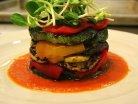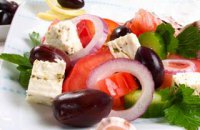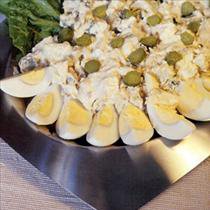SUGGESTIONS FOR YOUR HEALTHY EVERYDAY PLAN while cooking Gourmed's Recipes
Grains
• It is a good idea to include grains wherever possible, especially whole grains and their products like wholemeal bread, wild or brown rice, or wholemeal pasta and noodles.
• Bread comes in many varieties so why not offer a wide range and include wholemeal.
• If you are serving breakfast cereals, offer a variety and keep in mind low sugar, low salt and high fibre options and ... do not forget the trahana.
Dairy
• Always have a supply of low fat or skimmed milk to offer as an alternative to full fat for people eating with you.
• Make an effort to also cook with low fat milk.
• If you are serving cheese, why not provide lower fat varieties or reduced fat options.
• If you are using cheese as an ingredient, then try to use reduced fat or low fat varieties.
• Encourage having low fat milk or drinks made with low fat milk and fruit, as an alternative to sugar sweetened beverages.
• Instead of cream, sour cream and mayonnaise why not replace them with yogurt.
• Low fat varieties of yogurt can always make a great dessert.
• How do you like your eggs?... Give boiled, poached or scrambled eggs a try.
Meat and its products
• Aim at providing lean cuts of meat and trim off all the visible fat before cooking.
• It is better to remove any poultry skin before you cook or even buy skinless portions.
• If you plan to use sausages, ham, or salami make an effort to choose low fat options.
• Try altering the balance of a meat heavy dish by adding vegetables, beans, lentils, chickpeas, rice, or pasta.
• Poach, roast, grill or bake rather than frying.
• If you are going to fry then try to use unsaturated types of oil. Keep in mind that you need to change the oil regularly. It is also important to check if the frying temperature is correct.
Sweets
• Take some time to review your recipes: try substituting fats such as butter and lard with olive oil, or other vegetable oils, use fruit as a sweetener and add yoghurt and/or milk instead of cream.
• Try to use wholemeal flour in cakes, biscuits and pastries.
• Try to make smaller portions available.
Oils
• Make amends… swap all those products providing saturated or trans fatty acids for those that provide unsaturated fats instead.
• Try using vegetable oils and preferably olive oil rather than butter and margarine.
• Olive oil is a great seasoning so make it available to your customer e.g. put it on the table with the other condiments.
• Bake, steam, grill and roast foods rather than frying.
• If you are going to fry then try to use unsaturated types of oil. Keep in mind that you need to change the oil regularly. It is also important to check if the frying temperature is correct.
• If you are not already, why not try using olive oil in your recipes.
• Let the customer make the choice by allowing them to add their own dressing to dishes.
• If you are making sandwiches always ask before you add extra spreads.
• In case you offer butter or margarine spreads and dips to your customers why not try alternatives such as olive oil, vegetable paste or dip, fish paste or olive pate.
Vegetables
• By including vegetables and legumes in the majority of your dishes (all courses and for all types of meals) know that you are helping to increase the chances of people consuming them.
• Vegetable dishes make excellent main courses, so make sure to include them in your menu.
• There is always room for innovation so enrich your recipes with fruit and vegetables e.g. pork with plums or pears; chicken with orange;
various vegetables on pizzas or in soups and casseroles or try fruit cakes, fruit based desserts, etc.
• Go full steam ahead with vegetables and legumes as side dishes.
• Let the customer make the choice by offering a range of different undressed salads and dressings and let them create their own combinations.
• Try to have a number of dressings on offer such as olive oil, vinaigrette sauce, yogurt based dressings or low fat mayonnaise.
• When offering sandwich fillings don’t forget to have a good range of salads on offer. • It is a good idea to provide fresh fruit as well as fresh unsweetened fruit juice.
• Encourage the choice of fruit based desserts such as fresh fruit salads, summer puddings, fruit cakes or fruit yogurt.
• Make fresh fruit and vegetables more accessible to your customers by placing these choices front and center to grab attention.
• Cut and cook… it is best to cook your vegetables as soon as possible after you cut them.
• Cook and serve…don’t let vegetables sit too long; aim to serve them straight away.
• Steam, roast, grill or bake rather than frying.
Fish and Shell fish
• Smoked or canned oily fish and salad can make a tasty sandwich filling. Encourage the use of oily fish such as sardines, herring, salmon, mackerel and anchovies.
• Fish can also go with vegetables, beans, lentils, chickpeas, rice or pasta.
• Poach, roast, grill or bake rather than frying.
• If you are going to fry then try to use unsaturated types of oil. Keep in mind that you need to change the oil regularly. It is also important to check if the frying temperature is correct.
Various roots
• Instead of fried potatoes why not offer them baked, roasted or boiled or even provide other non-fried alternatives like vegetables, rice or pasta.
• If you must fry then cut the potatoes (or starchy roots) into thick pieces as the bigger the piece the less fat it absorbs.
• If you are going to fry then try to use unsaturated types of oil. Keep in mind that you need to change the oil regularly. It is also important to check if the frying temperature is correct.
Salt, herbs and spices
• Scale down the use of salt in cooking.
• When you are cooking, instead of salt why not use herbs, spices, lemon juice or vinegar. This is a good way to add flavour, highlighting the colours and importantly helping to gradually reduce the amount of added salt.
• Adding herbs and spices can be made easy if they are kept readily available, maybe next to the salt and pepper.

































































